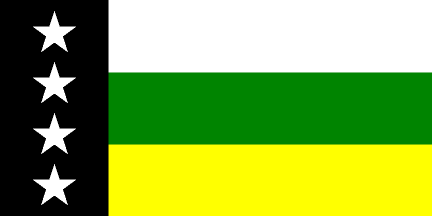
image by Pascal Gross, 15 Febuary 2001

Last modified: 2008-10-11 by dov gutterman
Keywords: ecuador | orellana |
Links: FOTW homepage |
search |
disclaimer and copyright |
write us |
mirrors

image by Pascal Gross, 15 Febuary 2001
See also:
Cantons:
There exists a new provincia of Orellana (since july 20,
1998).
Dirk Schonberger, 27 November 2000
It looks as though Orellana has been created out of the big Napo province.
Franc Van Diest, 30 November 2000
On July 30, 1998 the new province of Orellana (Ecuador) has
been created and, recently, we were looking for any information
about a possible flag for this new province. Hopefully, today
I've been able to find an image of this flag together with a
picture showing it flying at <www.ambato.com>. I've made an attempt of reconstruction of
this flag assuming that the black stripe is 1/4 of the length of
the flag. No information is available about the symbolism of the
colours but we can guess that the black stripe is here to
illustrate the petroleum exploited in this area.
Pascal Gross, 15 Febuary 2001
Orellana is an inland province of Ecuador. The capital is
Puerto Francisco de Orellana (also known as El Coca). The name of
the province derives from the explorer Francisco de Orellana who
is told to have sailed from somewhere near the town to the
Atlantic Ocean. He did this trip several times looking for the
gold city of El Dorado and in search of a rumored Nutmeg forest
which at the time was a very expensive spice. During his voyages
he met a ferocious tribe of Indians who attacked his ships and
many among them were women. This led to the naming of the river
as the Amazon river. The province is divided into four cantons.
Jens Pattke, 28 September 2008
v.gif)
image by Jens Pattke, 28 September 2008
At the pages <www.turismorellana.gov.ec>,
one finds the description of the Coat of Arms of the Ecuadorian
province of Orellana. I have foundthe image of the provincial
arms at a tourist brochure.
Jens Pattke, 28 September 2008
Translated from this web site:
"Based on a concept both ancestral and current. Made of a
central triangle meaning a lance head as well as an oil derrick.
In base, the flag of the Province of Orellana supports the
symbols. On the left side of the triangle, the flags of the
Cantons of Francisco de Orellana and Loreto; on the right side of
the triangle, the flags of the Cantons of Aguarico and Joya de
los Sachas. The cantonal flags are hoisted on natives' lances
made of "chonta"* decorated with "chambira"**
threads tied to them. Inside the triangle are placed the
following symbols:
- in upper point, an oil derrick, symbolizing the resources from
our subsoil;
- in the lower left part, a triangle of light colour,
representing the exuberancy and biodiversity of our Amazonian
forest; also pictured a Waorani*** together with a monkey, a
"chonta"* and a tatoo on a lance;
- in the lower right part, a celeste triangle with a tug boat,
representing navigation and trade with the neighbouring
countries, Peru and Brazil, and worldwide via the river Napo****,
tributary of the Amazone. Also recalling that we owe a genuine
treasure of water resource;
- in the middle of the main triangle, a sun in the center,
crossed by a green arc and a red parrot with its wings spread
over the arc, the arc being charged with four stars recalling the
four cantons forming the Province of Orellana;
- in the lower central part, an open book meaning science,
education, virtue and work, together with a cross recalling us
Christian love and solidarity.
The shield is crowned by the Ecuadorian Tricolour, with the
writing "1998 PROVINCIA DE ORELLANA 2001" symbolizing
and recalling our position of sentinels of the Amazonian border.
The name of the designer is Mrs. Dorix Cortéz, who has been
teaching her knowledge to children and youth for more than 20
years."
* different species of palms, which have been important to the
livelihood of indigenous peoples in the Amazon region since
ancient times: <www.exploringecuador.com>.
** Astrocayum chambira Burret, another palm of
significance for the indigenous peoples
*** a.k.a Huaorani or Waos. Some 4,000 individuals living on some
700,000 ha, constantly endangered by oil prospection and illegal
logging.
**** the first tributary of Amazon explored by the Spaniards, led
by Francisco de Orellana (1540-1541). Orellana (1511-1546)
founded Guayaquil and baptized the Amazon.
Ivan Sache, 29 September 2008